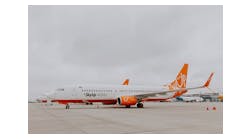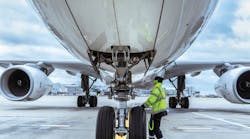Feb. 25—CLEVELAND, Ohio — The cost to airlines operating at Cleveland Hopkins International Airport skyrocketed last year, a function of the huge drop in passenger numbers and the facility's high debt.
The loss of revenue in parking, food and beverage, retail and other non-aeronautical areas has to be made up somewhere — and the airlines are bearing the brunt of it, said Airport Director Robert Kennedy, in a discussion with Cleveland City Council's Finance Committee this week.
The extra cost to the airlines couldn't come at a worse time — as carriers are dealing with catastrophic financial issues of their own because of the coronavirus pandemic, and as the city gears up to ask them for a huge sum to build a new terminal in the years to come.
"This is going to be a difficult discussion over the next couple of years," said Kennedy.
The airport's budget — projected to be $151.5 million in 2021 — must be balanced without any city tax dollars. Revenues come from both the airlines, in landing and other fees, and non-airline areas, including rent, parking and other sources.
In recent years, airport officials have worked to decrease the costs to airlines of operating at Cleveland Hopkins, by increasing parking and passenger drop-off fees, for example, with the goal of making the facility more competitive as it vies for new service.
The airlines funded 46% of the airport's costs in 2019. In 2021, the airlines' costs to operate in Cleveland will increase by $21 million and make up 66% of the airport's revenue, according to city figures.
The airport did receive $46 million in federal stimulus money in 2020, and is expected to receive another $9.7 million in 2021, but it's not enough to stem the losses from the steep drop in passengers.
Airport officials project that 5.2 million passengers will travel through Cleveland Hopkins in 2021, a 48% decrease from 2019 numbers.
Industry analyst Robert Mann said Cleveland isn't facing this financial crisis in isolation. "It's an industry-wide problem," said Mann, noting that the Port Authority of New York and New Jersey, which operates three of the nation's largest airports, recently asked the federal government for $3 billion to help make up revenue shortfalls.
He added, "Airlines aren't in a mood to see increases on anything."
At the same time, there's only so much that airports can do to reduce expenses. "You have to maintain the ramps and the runways," said Mann, principal at R.W. Mann & Co. in New York. "And you really don't save very much by mothballing a terminal."
In 2020, Hopkins' cost per enplanement — that's the average cost per passenger that an airline pays to operate at an airport — was projected to be $12. Instead, it was nearly $32, and is expected to be even higher in 2021.
Other airports in Cleveland's competitive set — Columbus, Pittsburgh, Cincinnati and others — also will see per-passenger costs increase, but are expected to top out at $10 to $15, according to Kennedy. "We are damaging our competitiveness," he said. "This is what drives airlines elsewhere."
Part of the reason for Cleveland's high costs is the airport's large debt, much of which stems from the construction of a new runway nearly two decades ago. At $645 million in 2019, Cleveland's debt is significantly higher than Columbus' $172 million, and Pittsburgh's $43 million.
Payment on the airport's debt in 2021 is expected to be more than $65 million — that's 43% of the airport's $151.5 million budget.
___
(c)2021 Advance Ohio Media, Cleveland
Visit Advance Ohio Media, Cleveland at www.cleveland.com
Distributed by Tribune Content Agency, LLC.




